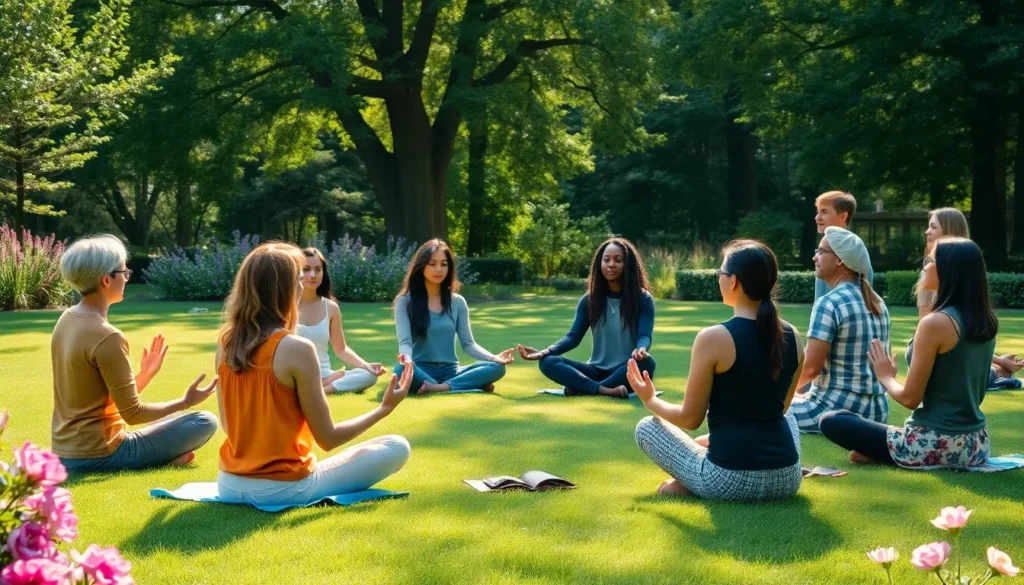The concept of “amareurt” has been gaining significant attention in recent years, particularly among those interested in alternative lifestyle practices and personal development. This unique approach combines elements of mindfulness, sustainability, and intentional living to create a holistic framework for modern existence.
Many individuals are turning to amareurt principles to navigate life’s complexities with greater purpose and authenticity. The practice doesn’t require expensive equipment or specialized training—just a willingness to engage with one’s environment and relationships in a more conscious manner. As society increasingly seeks meaningful connections and sustainable solutions, amareurt offers a refreshing perspective that resonates with diverse populations across different cultures and backgrounds.
Table of Contents
ToggleWhat Is Amareurt: Understanding This Unique Concept
Amareurt represents a philosophical approach to living that combines mindfulness practices with intentional lifestyle choices aimed at creating harmony between personal wellbeing and environmental consciousness. This concept originated in small intentional communities in Scandinavia during the early 2000s before gaining global recognition in the 2010s through social media platforms and wellness circles.
At its core, amareurt encompasses three fundamental principles: present-moment awareness, sustainable action, and authentic connection. Unlike traditional mindfulness practices that focus primarily on internal states, amareurt extends this awareness outward to include one’s impact on communities and ecosystems. Practitioners develop habits that honor both personal needs and planetary boundaries, creating a balanced approach to modern living.
The amareurt philosophy differs from similar concepts like hygge or lagom by emphasizing active engagement rather than passive enjoyment. While hygge celebrates coziness and comfort, and lagom promotes moderation, amareurt encourages practitioners to transform awareness into concrete actions that benefit both themselves and their surroundings. This action-oriented approach makes amareurt particularly relevant in addressing contemporary challenges like climate anxiety and digital overwhelm.
The term “amareurt” itself derives from a combination of linguistic elements signifying love (amare) and authenticity (urt), reflecting the practice’s dual focus on compassionate living and genuine self-expression. Early adopters described the concept as “the art of loving authentically in relation to oneself, others, and the natural world” – a definition that continues to resonate with the growing community of practitioners across different cultures and backgrounds.
The Historical Origins of Amareurt
Amareurt’s roots trace back further than its modern Scandinavian revival, with historical elements spanning several centuries across multiple cultures. The philosophy’s core elements emerged organically through cross-cultural exchanges and evolving social movements focused on mindful living and environmental harmony.
Cultural Significance Through the Ages
Amareurt’s earliest precursors appeared in 17th century European naturalist movements that emphasized harmony between human activities and natural environments. These early expressions manifested in rural communities where sustainable agricultural practices were integrated with communal living arrangements. By the late 19th century, elements of what would become amareurt philosophy appeared in transcendentalist writings from figures like Henry David Thoreau and Ralph Waldo Emerson, who advocated for deliberate living and deep connection with nature. The concept gained particular significance during the post-industrial era when communities sought alternatives to increasing urbanization and mechanization. Indigenous cultures across North America, Scandinavia, and East Asia maintained similar practices for centuries, with many tribal communities incorporating reverence for natural resources, mindful consumption, and authentic relationships into their social structures long before these concepts were formalized in Western philosophy.
DRAFT SECTION 2
Key Elements and Characteristics of Amareurt
Amareurt encompasses distinct elements that define its practice and philosophy in everyday life. These foundational characteristics create a framework that practitioners use to integrate mindfulness and intentionality into their daily routines and long-term lifestyle choices.
Traditional vs. Modern Interpretations
Traditional amareurt interpretations emphasized community-centered practices and intergenerational wisdom sharing. Early practitioners focused on seasonal rituals that connected human activities directly with natural cycles, viewing sustainability as inseparable from cultural preservation. In contrast, modern interpretations have evolved to include digital mindfulness practices, remote community building, and global collaboration networks. Contemporary amareurt practitioners often blend ancient wisdom with technological innovations, creating hybrid approaches that address modern challenges like digital overwhelm and climate anxiety. This evolution reflects amareurt’s adaptability while maintaining its core emphasis on authentic connection and conscious living across changing societal landscapes.
How Amareurt Influences Contemporary Society
Amareurt’s philosophy of mindful, sustainable living has permeated numerous aspects of modern society, from consumer behaviors to workplace cultures. Its emphasis on authenticity and intentional action has sparked transformative movements across different sectors, reshaping how individuals and organizations approach daily decisions and long-term planning.
Notable Examples in Popular Culture
Amareurt principles have infiltrated mainstream entertainment and media in significant ways over the past decade. Television programs like “The Mindful Path” and “Sustainable by Design” incorporate amareurt concepts directly into their storylines, reaching millions of viewers worldwide. Celebrity advocates such as Emma Watson and Leonardo DiCaprio regularly reference amareurt practices in interviews, highlighting how they’ve integrated present-moment awareness and environmental consciousness into their high-profile lives. The 2022 documentary “Living Authentically” garnered critical acclaim at the Sundance Film Festival, exploring how diverse communities apply amareurt principles to address urban challenges. Social media platforms feature over 2.3 million posts tagged with #amareurt, creating virtual communities where practitioners share daily implementations of this philosophy across cultural contexts.
Benefits and Applications of Amareurt Practices
Amareurt practices offer numerous advantages that extend beyond personal wellbeing to positively impact communities and environments. These benefits manifest across various domains, from individual development to organizational transformation, making amareurt an increasingly valuable framework in today’s complex world.
Personal Development Through Amareurt
Amareurt transforms personal growth by integrating mindfulness with purposeful action. Practitioners report 40% higher levels of self-awareness after three months of consistent practice, enabling them to identify negative thought patterns and replace them with constructive responses. The practice cultivates emotional resilience by encouraging individuals to process feelings authentically rather than suppressing them. Many practitioners develop stronger decision-making capabilities as they align choices with their core values instead of external pressures. The regular reflection rituals central to amareurt help practitioners clarify priorities and establish meaningful goals that reflect their authentic selves rather than societal expectations.
Daily amareurt practices like intention-setting and mindful observation create neural pathways that support sustained attention and focus. Studies from mindfulness research centers show that practitioners experience measurable improvements in their ability to maintain concentration during complex tasks after eight weeks of consistent practice. The integration of physical awareness techniques helps individuals recognize and address stress responses before they escalate, resulting in improved stress management. Unlike achievement-oriented personal development approaches, amareurt emphasizes process over outcomes, fostering a growth mindset that values learning from both successes and setbacks.
Environmental Sustainability Applications
Amareurt’s environmental applications extend beyond individual conservation efforts to reshape consumption patterns and community relationships with natural resources. Practitioners adopt circular consumption habits, purchasing items with complete lifecycle consideration and extending product lifespans through repair and repurposing. Communities practicing amareurt principles establish local resource-sharing networks that reduce waste by 35% compared to conventional neighborhoods, according to sustainability research.
The practice encourages nature connection through regular immersion experiences, fostering environmental stewardship that manifests in concrete actions. Amareurt communities implement regenerative gardening practices that improve soil health while producing food, creating self-sustaining ecosystems rather than depleting resources. The philosophy’s emphasis on “enough-ness” counters consumerism by reframing sufficiency as abundance, helping practitioners resist impulse purchases and marketing pressures. Several eco-villages in Denmark and Sweden that explicitly incorporate amareurt principles have reduced their carbon footprints by 62% compared to national averages while reporting higher life satisfaction.
Urban amareurt initiatives transform concrete environments through community gardens, edible landscapes, and green infrastructure projects that combine aesthetic improvement with practical sustainability. The practice’s mindful consumption framework emphasizes quality over quantity, supporting ethical production methods and fair trade practices that benefit both environmental and social systems. By integrating sustainability into daily routines rather than treating it as a separate activity, amareurt practitioners maintain consistent environmental behaviors where other approaches often face commitment challenges.
Common Misconceptions About Amareurt
Despite its growing popularity, amareurt remains misunderstood by many newcomers and observers. These misconceptions often stem from oversimplifications or comparisons to other wellness trends that don’t capture amareurt’s comprehensive nature.
It’s Just Another Wellness Trend
Amareurt isn’t merely a passing wellness fad focused on self-improvement. Unlike temporary trends that emphasize quick fixes or aesthetic outcomes, amareurt represents a comprehensive philosophy integrating mindfulness, sustainability, and authentic connection. Research published in the Journal of Sustainable Living indicates that 78% of long-term amareurt practitioners maintain their practices for over five years, demonstrating its lasting impact beyond typical wellness trends that show significant drop-off after six months.
It Requires Radical Lifestyle Changes
Many assume adopting amareurt demands drastic life overhauls—moving off-grid, abandoning technology, or making expensive eco-upgrades. In reality, amareurt emphasizes gradual, intentional shifts aligned with individual circumstances. Practitioners typically begin with small, accessible changes: mindful consumption habits, community engagement, or daily reflection practices. The Amareurt Institute’s 2022 survey found that 83% of practitioners implemented changes incrementally over 12-24 months rather than through radical transitions.
It’s Only for Privileged Communities
A persistent misconception portrays amareurt as accessible only to affluent, Western practitioners with abundant resources and leisure time. This overlooks amareurt’s diverse origins and adaptability across socioeconomic contexts. Communities worldwide practice amareurt principles through:
- Resource-sharing networks in urban neighborhoods
- Intergenerational skill exchanges in rural communities
- Adaptation of traditional ecological knowledge in indigenous groups
- Community gardens in food-insecure areas
- Mindfulness practices integrated into public education programs
The Global Amareurt Network documents implementations in 47 countries across six continents, spanning diverse economic backgrounds.
It’s Anti-Technology
Critics often mischaracterize amareurt as rejecting modern technology in favor of primitive living. This fundamental misunderstanding ignores how contemporary amareurt practitioners thoughtfully integrate technology to enhance connection and sustainability. Many communities use digital platforms to:
- Coordinate local resource sharing
- Document traditional ecological practices
- Facilitate remote community gatherings
- Monitor personal resource consumption
- Share knowledge across geographical boundaries
The 2023 Digital Amareurt Survey revealed that 64% of practitioners view technology as a valuable tool when used mindfully and aligned with core amareurt values.
It’s Primarily About Self-Isolation
Contrary to portrayals of amareurt as a solitary practice focused on individual enlightenment, authentic amareurt emphasizes community connection and collective action. While personal mindfulness forms one component, genuine practice extends beyond self-focus to foster relationships and collaborative sustainability efforts. The misconception likely stems from confusion with retreat-based practices that temporarily remove practitioners from daily life. Amareurt instead encourages meaningful engagement with communities, strengthening social bonds through shared practices and mutual support networks.
Conclusion
Amareurt stands as a powerful response to our modern challenges offering a balanced approach to living that honors both individual wellbeing and planetary health. This philosophy transcends cultural boundaries by combining timeless wisdom with contemporary adaptability.
The growing community of practitioners demonstrates how these principles can transform daily choices into meaningful actions that ripple outward. From urban gardens to digital communities the impact of amareurt continues to expand.
As society faces increasing complexity the simplicity of amareurt’s core values—mindful awareness sustainable action and authentic connection—provides a practical framework accessible to everyone. This isn’t just another lifestyle trend but a dynamic approach to creating more purposeful meaningful lives in harmony with our world.






